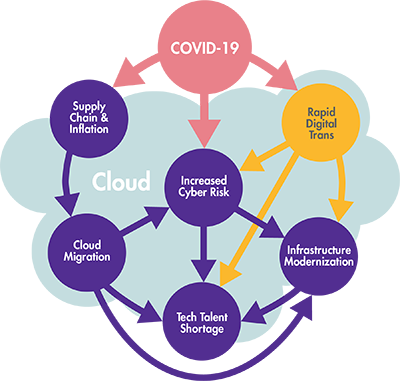No two years are exactly the same when it comes to IT budgeting, but the past several years have been more different than most. Simultaneous shortages, accelerations, and increased risk are forcing business leaders to rethink how they use and invest in technology.
Technology was important before the pandemic, but now it’s center stage.
From supply chain volatility and inflation to changes in cyber risk, cloud adoption, tech talent availability – and the need for infrastructure modernization— 2023 IT budgeting requires fresh thinking.
Global factors accelerating IT changes

The five key changes for IT budgets in 2023 are all cloud-related, some more than others. About 50% of Supply Chain changes, about 70% of Tech Talent Shortage and Infrastructure Modernization changes, and 100% of Cloud Migration and Increased Cyber Risk changes are directly related to the cloud.
COVID-19 kicked off a chain of events impacting every IT budgeting area for 2023.
To stay in business, companies rushed to digital transformation and completed projects in record time. A McKinsey Global Survey of executives found companies accelerated digitization for interactions and internal operations by three to four years, while their share of digital or digitally enabled products accelerated by seven years.
“Within months, most companies mobilized teams that figured out how to conduct business online and to work remotely at fundamentally different levels. We saw business leaders breaking down traditional barriers, working across functional silos to drive innovation, and using data and AI to sense and respond to changes in the external environment.” Karalee Close, Priorities for the C-Suite in 2022, BCG
The accelerated timelines proved something important to companies that were able to quickly move to the cloud — transformation doesn’t have to happen slowly. Companies that had previously been reluctant to move to the cloud saw the business benefits of a scalable, flexible way to engage with customers, deliver services, and get work done.
At the same time, the rush to the cloud left a wake of IT challenges for companies to deal with later — primarily security gaps, hybrid-environment issues, and other technical debt.
Companies need to provide the funds to resolve these issues in their 2023 IT budgets so they can keep moving forward and tackle new budgeting changes holistically.
The five key differences for IT budgeting in 2023
1. Supply chain volatility and inflation
The lockdowns and logistics problems that threw a wrench in supply chains continue, yet companies still need new hardware. The first wave of lockdowns halted the production of critical components like microchips used in all kinds of finished goods, including technology equipment, and new variants led to new slowdowns.
As economies boomed back, demand for scarce goods skyrocketed, contributing to global inflation.
Supply chain volatility and logistics shortcomings haven’t been resolved yet, and almost all technology components cost more than they did pre-pandemic and can take much longer to get. Inflation isn’t predicted to get back to normal next year either.
In 2023, companies need to budget more for the same IT components and be prepared to wait up to a year for delivery.
2. Cloud migration and converting to OPEX
As existing IT equipment ages out, companies face a dilemma. They are forced to either risk a cascade of potential problems as they wait for new equipment, move to the cloud, or find creative workarounds. Most companies are choosing cloud options — they’re available now and they work.
Cloud migration and converting to the OPEX model can defer a large CAPEX investment because there are fewer physical things to buy.
But keep in mind prices are now higher for cloud services, too, and subscription costs add up over time. Companies also need to invest resources to make transformation happen, including migration and integration, training employees on new platforms, and managing IT environments that have become more heavily hybrid.
Migrating more computing to the cloud in 2023, when possible, is the best solution to keep moving business forward.
3. The tech talent shortage
The tech talent shortage and related salary increases are impacting timelines in addition to bottom lines. Companies need workers with specialized skills, and these workers were in high demand even before the pandemic.
Experts who know how to translate infrastructure into code for software-defined solutions and security specialists with specific competencies are among the most sought after, yet high demand for IT workers covers the entire IT spectrum.
“CompTIA, a nonprofit association for the IT industry, counted more than 443,000 employer job postings for tech positions in the US in April, bringing the total to 1.6 million so far in 2022. That’s a 40% increase in US tech positions over the same period in 2021. At the same time CompTIA puts the US unemployment rate for technologists at 1.3%.” Mary Pratt, 10 Ways Inflation Will Impact IT, CIO magazine
Budgeting to recruit, train, and keep the tech talent you need is a critical 2023 priority.
4. Increased cyber risk
Increased cyber risk runs through nearly all of the changes for 2023 IT budgeting — and cybercriminals know it. Bad actors immediately began taking advantage of security gaps introduced by rapid digital transformation and continue to devise new lines of attack that are ever-more disruptive for companies and profitable for themselves.
Money isn’t the only current motivation, however. Cybercriminals can hit thousands of victims at once to disrupt supply chains and the economy by infiltrating ubiquitous enterprise software for geopolitical reasons.
Add growing vulnerabilities — aging systems, zero-day threats, and poorly monitored endpoints — and companies face multitudes of cyber risks simultaneously.
Most companies plan to spend more in 2023 to quickly address these risks and protect their businesses and business continuity.
5. Infrastructure modernization
Modernizing infrastructure is the answer to many of these challenges. It lays the foundation for changes companies need to make now and will want to make in the near future.
With modern infrastructure, companies can gain a lot of advantages. They can access more effective and sustainable business options, prepare IT environments for further digital transformation (including leveraging AI), and better protect their data — new technology and methodologies are more nimble and have built-in security capabilities.
Companies that were born in the cloud or had modernized pre-pandemic had a leg up when COVID-19 hit, and the rest now understand the value of being ready to reassess, pivot, and quickly adjust.
“When an organization has stabilized and optimized its existing IT estate and is ready to realize next-level cloud value, it will need to rethink its approach to technology infrastructure, networks, people and workplaces. That’s no easy thing to do. But those who can find the right balance will unlock new levels of competitiveness and unleash a wave of innovation opportunities.” Philippe Chauffard, et al., Ever-ready IT infrastructure report, Accenture
In 2023, forward-thinking companies are budgeting to systematically modernize their IT infrastructure to take advantage of as many options and opportunities as possible.
The cloud is the connection
All of the main differences in IT budgeting for 2023 deal with circumstances generated by the pandemic and involve the cloud either entirely or partly:
- Supply chain volatility and inflation
- Cloud migration
- Increased cyber risk
- Tech talent shortage
- Infrastructure modernization
When you develop a 2023 IT budget strategy that addresses these changes holistically, your IT investments will align with your business priorities and pay off long into the future.
These 2023 changes were coming anyway — COVID-19 just sped them up.
For a deeper discussion of the five key budget changes and how they impact your 2023 budget, download Leapfrog’s report, Making Sense of What’s Different for IT Budgeting in 2023.

